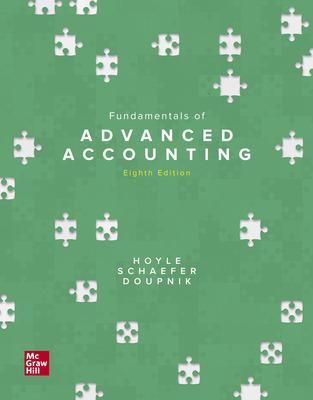Question
QUESTION 1 Which one of the following is not an obstacle to comparability? A.Standardisation B.Culture C.Different taxation systems D.National modifications QUESTION 3 Which one of
QUESTION 1
Which one of the following is not an obstacle to comparability?
A.Standardisation
B.Culture
C.Different taxation systems
D.National modifications
QUESTION 3
Which one of the following is an example of a fundamental qualitative characteristic:
A.Relevance.
B.Understandability.
C.Verifiability.
D.Comparability.
QUESTION 5
Which one of the following statements about Other Comprehensive Income (OCI) is not true?
A.Many users are thought to ignore OCI as the changes reported are not caused by the operating flows used for predictive purposes.
B.Opinions vary but there is a feeling that OCI has become a dumping ground for anything controversial because of a lack of clear definition of what should be included in the statement.
C.OCI items are transitory in nature.
D.The basis for reporting items in OCI is conceptually sound.
QUESTION 6
The classification of a preference share as an equity instrument or financial liability is:
A.affected by an intention to make distributions in the future.
B.not affected by a history of making distributions.
C.not affected by the other rights that attach to them if they are non-redeemable.
D.affected by a history of making distributions.
QUESTION 7
A compound financial instrument is one that:
A.ultimately requires the exchange of a financial asset for an equity instrument.
B.effectively contains a financial liability and equity instrument.
C.offers interest terms such that interest is paid on interest.
D.transfers the risks of a primary instrument to another entity.
QUESTION 8
Which of the following is not a financial asset?
A.Accounts receivable.
B.Cash.
C.Inventory.
D.Shares in another entity.
QUESTION 12
A defined contribution superannuation plan is one in which:
A. the contributions to the plan are only paid out to members on retirement.
B. the benefits paid out by the plan are based on the average salary of an employee over a period of years as a reflection of the employee's contribution to the employer.
C.the benefits paid out by the plan depend on the contributions made to the plan and the earnings of that plan.
D. the contributions are defined by the amount needed to pay out benefits to the members at a specified level on retirement.
QUESTION 13
Boris Johnson works for BankOf Australia Ltdand has taken his long-service leave this period. He was paid $2450 as his entitlement. What account(s) is/are debited in the entry to record this event?
A.Long-service leave expense and PAYG tax deduction.
B.Provision for long-service leave and PAYG tax deduction.
C.Long-service leave expense.
D.Provision for long-service leave.
1 points
QUESTION 14
Which of the following share-based payment transactions are considered cash-settled transactions within the scope of AASB 2?
A.Company A grants 5000 options each to its directors in return for services to be received over two years; Company B purchases machinery in exchange for shares.
B.Company C incurs a liability based on the price of the entity's share options to pay for the services of its sales executives.
C.Company A grants 5000 options each to its directors in return for services to be received over two years.
D.Company B purchases machinery in exchange for shares.
QUESTION 16
Positive Accounting Theory suggests that bonus schemes benefit:
A.Only managers
B.Neither managers nor owners
C.Both managers and owners
D.Only owners
QUESTION 18
The claimed benefits of international standardisation include:
A.Improved quality of reporting increases comparability and lowers cost of capital.
B.Lower compliance costs leading to lower cost of capital.
C.Differences in legal systems reduces cost of capital.
D.International comparability reduces cost of capital.
QUESTION 19
Which of the following items are set out in the Conceptual Framework?
A.The definition, recognition and broad measurement criteria for accounting elements.
B.The purpose and objectives of financial statements.
C.Conditions that allow a change in accounting policy.
D.The criteria for offsetting assets and liabilities.
Step by Step Solution
There are 3 Steps involved in it
Step: 1

Get Instant Access to Expert-Tailored Solutions
See step-by-step solutions with expert insights and AI powered tools for academic success
Step: 2

Step: 3

Ace Your Homework with AI
Get the answers you need in no time with our AI-driven, step-by-step assistance
Get Started


